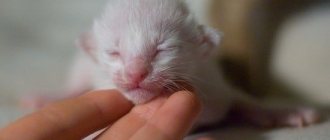Who are roundworms - Ascariasis in cats
Roundworms are dioecious roundworms that are characterized by sex differences in size. Females are usually much larger than males. Most often, roundworms infect the gastrointestinal tract of cats, although some species can colonize the bile ducts and pancreas.
Cats are characterized by 3 types of roundworms:
- Toxocara leonine - females usually reach 10 centimeters in length, and males - 6 cm. The body has a yellowish tint. And the head section is equipped with lateral wings and has three lips. It has a simpler cycle, unlike Toxacara catti. The eggs are excreted from the body of the main host (cat or dog) along with the feces, within 4 days it “matures” - at this time the larva inside moults, thus the egg becomes active for infection. Then the eggs can directly enter the cat’s body, or by eating an intermediate host - a rodent. Not dangerous for people.
- Toxocara mystax or Toxacara catti - The main causative agent of ascariasis (toxocariasis) in cats. Males are usually much smaller than females - from 3 to 6 cm, while females are more than 10 cm. To reach sexual maturity, the parasite migrates in the cat’s body and spreads from the intestines to the lungs and liver, and also damages other organs. From the trachea, the larvae, when coughed, again enter the digestive tract and complete the cycle. Dangerous for humans.
- T. canis affects not only dogs, but can also parasitize the intestines of cats. The development cycle completely repeats that of the feline Toxocara. It is also dangerous for humans, although it does not undergo a full cycle in the body; humans are intermediate hosts.
The main danger of roundworms is their high contagiousness. When the soil is infested with eggs, they can persist for several years, becoming a source of disease.
What are roundworms and what do they look like?
Roundworms that parasitize cats are roundworms that vary in size and gender. They live most often in the intestines, but are sometimes found in the pancreas, gall bladder, and other organs.
Appearance of cat roundworm
Three species of roundworms parasitize the digestive tract of domestic cats, and all of them are classified as representatives of the nematode suborder Ascaridata of the genus Ascaris. The pathology caused by the presence of nematodes in the body of cats is called toxocariasis.
The causative agents of toxocariasis differ morphologically and also externally.
Table 1. Types of roundworms
| Name | Appearance Features |
Toxocara cati | Light yellow worms, the males of which are up to 5 cm in length, and the females are twice as large. The eggs are brown, spherical in shape, with a thick and rough wall. Their sizes are up to 65×75 microns |
| Toxocara leonina | Yellow helminths, from 6 to 10 cm in length. Eggs are smooth, thick-walled, oval or round, with a diameter of up to 80 microns |
Toxacara canis | Large gray-yellow worms with a length of 94 to 18 cm. In males, the tail is curved. The parasite lays eggs of a round shape, gray in color, in which the cellularity is clearly visible |
Causes
Ascariasis in cats. The main route of transmission is through soil, food, grass, and furnishings contaminated with worm eggs. Parasites can get on the animal's fur and settle in the intestines through licking.
Another alternative route of infection is an intermediate host. In them, roundworms cannot reach sexual maturity and are encapsulated in the nervous system and muscles. A cat becomes infected by eating an infected animal. Rodents, earthworms, frogs, pigs, birds and sheep can act as intermediate hosts.
If the female is pregnant, then infection of the offspring occurs through the umbilical vein directly into the lungs. There, the parasites enter the kittens' trachea, subsequently migrating into the intestines and completing the maturation process. This method of infection is typical for canine toxocara, while Toxacara catti does not infect the fetus.
Toxocara also infects offspring during breastfeeding, entering the intestines through milk.
One infected cat per day can excrete about 100,000 eggs in feces, which are contained in just 1 gram of feces.
Doctor Komarovsky about worms in children
Have you been fighting against PARASITES for many years without success?
Head of the Institute: “You will be amazed at how easy it is to get rid of parasites just by taking it every day.
Worms surround us everywhere, and it is quite difficult to protect ourselves from them. Their larvae, located in the ground, are able to withstand both heat and cold. Therefore, it is very important to know what the routes of infection with worms are and methods of treatment. The popular health program “Doctor Komarovsky’s School” touches on the topic of helminthiasis in children. What does Komarovsky recommend, worms - how are they dangerous for a child’s body, how to prevent infection?
Our readers successfully use Intoxic to get rid of parasites. Seeing how popular this product is, we decided to bring it to your attention. Read more here...
Causes and ways of infection with worms
The most common cause of worm infection is violation of hygiene rules.
Let's look at the main routes of infection:
- Contact method. A child can become infected through contact with other children or from their parents. When using other people's things, toys, bedding. Contact with animals is especially dangerous. Many pets play outside, picking up anything from the ground. And kids love not only to cuddle the animal, but also to kiss it. Although it is believed that many worms found in pets do not live in the human body, hygiene rules should not be forgotten.
- Water carries a huge danger for children. When swimming in bodies of water, they can often swallow water. Children often come running from a walk, open the tap and drink straight from it. Transmission of worms through water is a common way of infecting children. The child should be taught to drink filtered, bottled or boiled water. This will help prevent not only helminthiasis, but also many intestinal disorders.
- Infection through food is also common. Meat and fish are considered especially dangerous products. Semi-finished fish and meat products must undergo full heat treatment so that the child does not become infected. You cannot cook with blood, as some people like to do. Do not defrost or store meat next to other foods. In addition to meat and fish dishes, vegetables, berries and fruits pose a danger. You cannot feed children strawberries from the garden without washing them and pouring boiling water over them. Many people believe that since they do not fertilize the garden with anything, it means that everything can be eaten unwashed. This is a dangerous misconception. After all, there are animals running around there, which, by defecating, can infect the ground and the berries and vegetables growing on it with worms.
- Insects are intermediate carriers of helminths. Therefore, we need to fight them. Flies, mosquitoes, fleas should not be present in rooms where people live. Flies love to sit on feces and then take a liking to a plate of salad or other tasty dish. This is how worms get into prepared food. Mosquitoes and fleas transmit helminthiasis through bites. You can use a spray or cream against mosquitoes if you plan to relax outdoors. A fumigator with a plate or liquid must be turned on in the room.
Symptoms - Ascariasis in cats
Ascariasis in cats. In adults, toxocariasis rarely causes symptoms of the disease. Mostly, signs of the disease appear in kittens. Typically characterized by stunted growth and lack of weight, an enlarged abdomen and dull coat.
The offspring also develop:
- Anemia, expressed in pallor of the mucous membranes and skin.
- Diarrhea and vomiting. Blood may be found in the stool.
- Possible increase in temperature.
- Itching of the anus, due to which the cat will constantly lick it.
Due to the migration of larvae, cats may experience complications due to damage to internal organs:
- Pneumonia.
- Ascites.
- Peritonitis.
- Cough (due to the release of larvae into the trachea).
- Liver damage.
If there are a large number of parasites, the kitten may develop intestinal obstruction, causing constipation. The bile ducts are also blocked, leading to obstructive jaundice.
Symptoms
Weak infestation (2-3 worms) is characterized by the cat losing weight against the background of increased appetite. Small kittens suffer from pneumonia, diarrhea, exhaustion, and fever. The abdomen swells, the mucous membranes become pale, which indicates anemia, the kitten is stunted and looks very thin.
The following symptoms may also be present:
- Vomit.
- Fidgeting with the anus on the carpet.
- Disheveled wool.
- Souring of the corners of the eyes.
- Cough.
- Blood in the stool.
- Cramps.
Parasites living in the intestines lead to the loss of most nutrients, gradually depleting the cat's body. If the infestation is severe, she may completely refuse to eat.
Signs of roundworms in cats
Ascariasis in cats. In order not to miss toxocariasis in a pet, the owner must be attentive to its well-being and condition. There is a list of signs by which one can suspect a helminthic infestation in a beloved cat:
- decreased activity of the animal - it sleeps a lot or lies motionless;
- growth and development delay in young animals;
- dull and falling out fur;
- thinness against the backdrop of a “brutal” appetite;
- periodic indifference to food;
- disproportionately large abdominal volume, as with bloating;
- worm eggs on the animal’s “pants” and around the anus, which is most noticeable when the fur is long and dark;
- pale tint of mucous membranes is one of the signs of anemia;
- vomiting and diarrhea, sometimes with blood and worms;
- persistent itching in the anal area, which causes anxiety in the animal and leads to the cat aggressively licking the anus.
Symptoms
It was already mentioned above that the greatest problems for the body from roundworms are caused to kittens aged from a couple of months to three.
- If we talk about the main symptoms, the following are distinguished:
- elevated temperature;
- nausea;
- diarrhea;
- pain in the lungs, cough;
- rapid weight loss;
- convulsions that resemble epilepsy and similar seizures;
- brittle wool;
- licking the anal area;
- the stomach becomes round and swollen;
- obstruction develops in the intestines, in addition to diarrhea, there are also manifestations of constipation; if the animal does go to the toilet, then an admixture of blood and blood clots appear in the feces.
How dangerous is ascariasis for cats?
Roundworms in cats cause the chronic disease toxocariasis. In principle, even the name “roundworms” for roundworms that parasitize the body of cats and dogs is not entirely accurate. Toxocara leonina, Toxocara mystax, Toxacara catti live in the intestines of cats and dogs. You can see how they look in the photo. These parasites belong to the general suborder of roundworms (nematodes) Ascaridata of the genus Ascaris. It has been clinically proven that roundworms in cats and dogs cannot cause helminthic infestation in humans.
Ascariasis in cats. Dog or cat roundworm eggs will not be able to develop in the human body, even if they are purposefully “planted” there. This is due to the fact that human roundworm develops in the intestines at a temperature of 36.6 degrees, and roundworms of cats and dogs develop at a temperature of 38.5 - 39 degrees.
A person can become infected with other worms from animals, so pets need to undergo a full course of deworming once every 3 months, and if a helminthic infestation is diagnosed, they need adequate treatment.
Diagnostics
Diagnosing and identifying roundworms can be a challenge even for an experienced veterinarian. Based on external signs and symptoms, the doctor can only assume that the cat has toxocariasis, after which the turn of diagnostic tests comes. First of all, a scatological examination of stool is carried out to identify eggs.
In order to be sure of the result, the veterinarian must obtain the data three times, so samples are submitted for analysis at least 3 times at intervals of a week. This is necessary because a negative result may be a sign of a stage of infection in which there are no mature roundworms in the cat’s body yet or the female did not excrete eggs at the time of stool collection.
To detect parasites, you need to adhere to the following rules:
- collect the sample in the morning, when the number of eggs in feces is maximum;
- deliver the analysis to the laboratory in the shortest possible time, and if this is not possible, then a hermetically sealed container with the sample should be placed in the refrigerator until the owner can go to the veterinary clinic.
Clinical tests to identify helminths are rarely prescribed; most often they prefer to immediately use drug deworming. After taking special medications, in 90% of cases it is possible to determine whether helminths have parasitized the cat’s body, since dead individuals are excreted in feces and become clearly visible.
Ways of infection of pets
Ascariasis in cats. Even if your pets are constantly at home, the possibility of ascariasis in cats cannot be ruled out. An animal may “just for a second” jump out onto the landing, or may sniff and lick your outdoor shoes, which almost always contain worm eggs.
Puppies and kittens can ingest eggs in their mother's milk or become infected in utero from a sick mother. Before mating, animals must undergo anthelmintic treatment.
With the feces of a sick animal, fertilized eggs of parasites fall into the soil, where, under favorable conditions, the maturation process occurs. Microscopic mature worm eggs are carried by flies, ants, and shoes. Gusts of wind during drafts, along with dust, can be carried into the apartment through open windows. It is noteworthy that in direct sunlight the eggs die within a couple of hours, but they can tolerate frost down to -25 degrees, just being on the surface of the earth.
Only regular wet cleaning, disinfection of trays, maintaining a sanitary culture of housing, regular deworming and proper treatment can protect pets from parasites.
Prevention
Veterinary drugs for the prevention of ascariasis are available in the form of tablets, syrups, suspensions or drops. For small animals, it is better to take drops or syrup, as swallowing the tablet may be difficult for them. Manufacturers make modern deworming products with the taste of meat, fish or other products so that the animal does not throw it away.
If this doesn’t work, then you need to stick the tablet into a piece of cheese, melt it in the microwave for a few seconds, judge it and give it to the animal. The taste of hard cheese is very strong and can easily drown out the smell and taste of the tablet. So you won’t have to forcefully prevent ascariasis in cats.
- Timely preventive deworming. For cats visiting the street - once every three months, for pets - once every six months.
- Put outdoor shoes in the closet to prevent your pet from coming into contact with them.
- Avoid eating birds and rodents.
- Be sure to carry out deworming treatment when planning mating.
- Place a shoe mat in front of the door.
- Clean the litter box regularly.
- It is advisable to limit free access to the street.
- Mandatory flea treatment and wearing a special collar or using drops on the withers.
- It is advisable to choose ready-made commercial food, and also exclude raw fish and meat.
- Using purified water.
One of the most common parasitic diseases in pets is ascariasis. According to statistics, almost every pet suffers from it at least once in its life. Roundworms (worms) appear more often in cats than in other animals due to the specific diet that may contain pathogens. How the disease will progress and whether it will be difficult to get rid of it primarily depends on the general state of immunity and health, as well as on the timely actions of the owner.
In veterinary practice, the official name of this disease is often used - toxocariasis. It comes from the name of the genus of roundworm that causes this pathology and bears the Latin name Toxocara.
Are roundworms in cats transmitted to humans?
Quite often, when we see an infected animal, we reflexively scare it away, fearing infection. This is one of the most popular myths. The opinion that roundworms in cats are transmitted to humans turns out to be erroneous.
The fact is that round intestinal worms in animals do not take root in the human body. There is an opinion that large roundworms in the body of a pig can take root in humans, but this has not yet been proven by science. The very way of infecting a person with worms is as follows: viable eggs can enter the body only through the soil, and only from person to person.
Traditional methods of treating roundworms
There are also traditional methods for removing roundworms from a cat’s body. It should immediately be pointed out that medications are more effective and more accurate than decoctions. Traditional medicine is a last resort that can be resorted to if there is no better way out. The composition and methods of preparing herbal remedies that fight worms can be read below.
Alternative Treatments
Danger to humans
Ascariasis in cats. Although the worm cannot undergo a full sexual cycle in the human body, it can still act as an intermediate host. Once in the intestines, the larvae migrate to the muscles, central nervous system, eyes, liver, lungs and heart. There the larvae are encapsulated.
Toxocariasis is especially dangerous for children, in whom it can cause serious complications and lead to death.
Basically, the disease in people manifests itself with vomiting, diarrhea, and a sharp increase in temperature. Depending on the affected organ, decreased vision and anorexia can be observed.
Due to the high fertility of parasites, eggs can reach a person even after stroking a pet. Therefore, washing your hands after playing with your pet is strictly necessary!
Among all cases of infection, the largest percentage accounts for Toxacara canis, while feline roundworms occur in isolated cases.
Mechanism of infection
The life path of roundworms consists of several stages. The first is when eggs are released into the environment. This is done through the feces of infected animals.
For further development of eggs and formation of larvae, favorable conditions are needed:
- high humidity;
- warm air.
Parasites enter the new host's body through food or drink. The shell of the eggs is exposed to digestive juice, and it dissolves it. The larvae emerge and penetrate the intestines. They travel with the blood to the lungs, where development is completed.
After some time, the larva migrates into the bronchi, after which it coughs into the mouth, is swallowed and ends up in the small intestine. Roundworms become adults.
Parasites are ubiquitous. Adult cats and kittens can get sick. Babies under three months of age are most susceptible to infection. They take it hard and often end in death.
There is another way to get roundworms - through the womb. Therefore, if a cat is infected, then her kittens are too. Backyard animals eat rodents, which may be carriers of worms.
Diagnostics - Ascariasis in cats
The main diagnostic method is to examine stool for worm eggs. It is necessary to carry out three samplings to exclude weak infestations. Tests are carried out at intervals of 10 days, during which time the helminths will be able to reach sexual maturity and begin to secrete eggs.
In rare cases, adults can be found in it. Worms are also found in vomit.
It is advisable to perform an ultrasound of the abdominal cavity to exclude blockage of the intestinal lumen and bile ducts. X-rays can also be taken using barium contrast.
What to do?
Treatment with drugs
Therapy for toxocariasis involves taking only veterinary anthelmintics. Considering that several types of worms coexist in a dog’s body at the same time, drugs for treatment must be broad-spectrum.
- Gelmex is acceptable for treating even 3-week-old puppies; minimum side effects.
- Tenac has a wide spectrum of action: it is effective not only against Toxocara, but at the same time destroys tape and whip-shaped parasites. Strictly contraindicated in dogs with heartworms and does not allow wearing a flea collar. In this case, Tenac is replaced by Verkom, Caricide, Panacur or Mebendazole.
- Milbemax is an effective product flavored with the smell of meat.
- Prazitel is a suspension for both puppies and adult dogs.
- Kanikquantel is a highly toxic drug. Eliminates ascaris after a single dose. It is prescribed to puppies with great caution.
- Helminthal C – used to eliminate roundworm eggs in a dog’s fur.
the drug Ivermectin is strictly contraindicated for puppies under 4 months and dog breeds with a dolichocephalic head shape: collies, collie mixes, some terriers, bobtails, shelties and briards. There is a threat of severe intoxication with fatal outcome.
Drontal or Drontal plus and oxybendazole-based products also show excellent results For example, Polyverkan .
Regardless of the specific drug, in most cases treatment is repeated after 2 or 3 weeks. In this way, the maximum number of constantly migrating larvae will be destroyed.
Deworming at home
The dosage of any anthelmintic drug should be selected by a veterinarian in strict accordance with the weight of the dog. Particular caution is exercised when prescribing dosages for puppies. Treat toxocariasis exclusively in the clinic.
Traditional methods
Various folk remedies are questionably effective even in treating helminths in people, not to mention dogs. It is unlikely that the animal will be happy to eat garlic or pumpkin seeds. And delay without full treatment for toxocara in a puppy can result in his death.
Can they go out on their own?
Spontaneous release of roundworms with excrement or vomiting occurs in cases where the number of helminths has become critical. In such a situation, the animal needs emergency veterinary care.
Treatment
Ascariasis in cats. Therapy for toxocariasis is as simple as for most helminths. Usually used anthelmintics - pyrantel, albendazole. These drugs cause complete paralysis of adult worms and have a detrimental effect on eggs and larvae.
Drug dosage regimen:
- Pyrantel – 5 mg per kg of body weight orally once.
- Azipirin – 0.5 tablets once.
- Levamisole – 7 ml per kg subcutaneously.
Therapy is repeated 2 weeks after the first dose.
If there is a deterioration in the kitten’s condition, they may be prescribed Gamavit, an infusion of infusion solutions. In case of massive invasion, antihistamines and corticosteroids can be used to relieve intoxication.
If there is a blockage in the intestines or bile ducts, surgery is performed.
Be sure to sanitize the cat's bowl, drinking bowl, tray and bed. All blankets and blankets on which the cat sleeps should also be treated with disinfectants. Wash floors and surfaces.
Treatment for humans
Ascariasis in cats. Usually, treatment for ascariasis caused by cat or dog Toxocara is not required; the disease goes away on its own over time. The exception is damage to the eyes and central nervous system. Antihelminthic drugs are also used, and surgical removal of parasites is possible.
Epizootological data
Mainly young animals, such as pigs, dogs, horses, and chickens, are susceptible to ascariasis. Ascariasis is widespread everywhere. If the intensity of the invasion is high, the disease is severe with a high mortality rate.
Roundworms, being small parasites, quite often mechanically damage the intestinal walls. Accumulating in the intestines, they often cause blockage and even rupture. During the process of growth and vital activity, parasites secrete quite toxic substances that enter directly into the animal’s body.
They affect the central nervous system, causing both excitation and inhibition, sometimes even paralysis. The larvae, while migrating, destroy tissues and blood vessels. By introducing themselves into the intestinal mucosa, they injure it, opening the entrance to viruses and bacteria. In the lungs, the larvae, injuring the alveoli, cause migratory pneumonia.
Popular medications for worming in cats
If someone tried to view and compare instructions for deworming products for cats, they noticed that almost all tablets usually contain two substances:
- one of which acts on roundworms (usually piperazine, pyrantel, fenbendazole, milbemycin or emodepside),
- and another is effective against flukes and tape parasites (praziquantel).
Therefore, trying to identify something extraordinary and super-effective among them is quite difficult, since their chemical substances are basically the same and they work against the same helminths:
- Tohosaga cati,
- Ancylostoma tubaeforme,
- Ancylostoma braziliense,
- Echinococcus granulosus,
- Echinococcus multi-locularis,
- Dipylidium caninum
- Taenia spp.,
- Mesocestoides spp.,
- Joyeuxiella sp.
This group of universal products with the same set of active ingredients includes:
- drontal - tablets, used from three weeks of age;
- Profender - drops, approved for use from five weeks of age,
- prazicide - suspension, not recommended for babies under three weeks of age;
- pratel - tablets;
- troncil K - used for kittens from 3 weeks;
- febtal - tablets based on fenbendazole;
- kaniquantel - used for cats and kittens starting from three weeks;
- milbemax (not earlier than six weeks of age) - it is worth highlighting because the active substance (mibelmicin oxy) against nematodes not only kills intestinal helminths, but also acts on dirofilaria, which live in the bloodstream and heart of the animal.
Unlike these drugs, polyvercan is based on other active principles: niclosamide (cestodic action) and oxybendazole (anti-nematode), but at the same time it also retains the title of a broad-spectrum anthelmintic.
In pharmacy kiosks you can find another antiparasitic drug in the form of drops - Inspector, which not only has anthelmintic properties, but can also simultaneously act on fleas and ticks, which is very convenient: you can get rid of all parasites in one go. It contains two chemicals:
- Fipronil is an excellent insecticide that, after application to the skin, tends to accumulate in its lubricant and hair follicles. Released over a long period of time, it ensures long-lasting activity. It is not recommended for use in kittens under 3 months of age, as well as in sick and old animals, due to possible negative consequences;
- Moxidectin belongs to the group of avermectins, but unlike ivermectin, it does not cause signs of poisoning in cats, even with an overdose. Works well against roundworms and is an excellent means of preventing dirofilariasis. If the test for microrofilaria and adults is positive, it is prescribed with caution, due to the high probability of the animal dying from intoxication as a result of the decay of helminths.
Recently, information has appeared that the drugs drontal, prazitel, and prazitid are often counterfeited, so you should be careful with their use. Not only will these remedies not rid your cat of worms, but they can also be fatal. Therefore, if you are not sure of the quality of the medicine, and the veterinary pharmacy does not have a license for it, then it is better to refuse such a dubious purchase.
Treatment. How to get rid of worms?
Antiparasitic drugs are used for treatment . There are many medicines with different compositions on the market. Everyone has their own dosage, as well as the course of their taking. The veterinarian determines the pet’s personal characteristics and then identifies the type of worm. After all, different drugs are used against each of them. There are also universal medications , but they are not so powerful and are not always able to help in later stages. They are used rather for prevention in the first stages of the disease.
For this reason, you cannot treat yourself
. After all, if you do not identify a specific worm, treatment will simply be to no avail, and this, in turn, means that the parasite will only develop and gain strength. This is much more difficult to cure.
In addition to tablets, drops . This format is sometimes more convenient than the tablet format, which is not so easy to give to a cat. Oral, they are given to the animal twice at intervals of two weeks until complete recovery.
However, it is worth remembering that if the treatment has been going on for more than a month, and there are almost no results, this means that the parasites have already become accustomed and adapted to the drug. It is worth remembering what medications the animal has already been treated with, because if there is a change of veterinarian to another, it is important for him to know so as not to repeat it.
It is also important to maintain sterility and disinfect any surface that your pet touches. You also need to clean him himself, because the eggs spread through the fur as well. The larvae die from any household chemicals, so the use of bleach is not always necessary, although it is desirable. However, if you don’t have it on hand, even regular soap will do just fine.
Are cat worms dangerous for humans?
For many people, the concepts of “worms” and “cats” have long merged into an inextricable whole. And this really has a basis. The vicious circle of such symbiosis can and should be broken. But it is worth knowing your enemy “by sight”, as well as his methods of penetration in order to prevent infection with worms from a cat.
What types of helminths settle in furry pets?
No one will argue that worms in any form are dangerous. Humanity knows several hundred types of invasions, which are divided into three main types:
- First. Round (nematodes). This is what they look like: round. More than 20 thousand species have already been included in this point of the general classification of worms.
- Second. Flat or ribbon (cestodes). They are flat or ribbon-like. There are more than 3,000 species, but they are more harmful than the previous representatives of parasites on this list. Their sizes are more impressive (up to 30 meters). And fertility drives you crazy! Some of them save up to 600 million per year.
- Third. Flukes (trematodes). Here the name in the type classification takes into account the external indicator: the presence of suckers. There are more than 500 species.
All of the above army of worms can infect a person. Sources of infection are varied. These are: water, food, and air.
As already mentioned, cats are an excellent “home” for those who love to suck the intestinal walls and blood. Some owners sleep peacefully with their pets, thinking that isolation from the outside world will defeat cat worms. We must not forget that infestations can be contracted through raw fish and meat. The owner's shoes are also full of harmful larvae. Tomboys sometimes want to remember that they are predators and swallow flies and climb into the trash can. And this way you can also become infected. Therefore, no matter what conditions you create for your cat, there is reason to prepare for the war against worms.
Of course, the range of nasty immigrants is not as wide as that of humans, but still the list is significant. Most often in cats you can find representatives of the first and second groups of worms listed above. The whole picture is complicated by the fact that most of the parasites that have chosen the body of cats as a home are biohelminths. Their distinctive feature is that the development cycle takes place in living substances, which include animals (including cats) and humans.
Although, to the credit of pets, it should be noted that there are types of helminths that are not interested in the host’s body. For example, hookworms, which prefer to live exclusively in the intestines of small kittens. They are not dangerous for people.
Our readers recommend! For the prevention and treatment of parasitic infestations, our readers recommend the Bactefort parasite remedy. It consists exclusively of medicinal plants collected in environmentally friendly places, which are extremely effective in cleansing the body of parasites, and also heal and protect the body as a whole. Doctors' opinion..."
How does infection occur?
Once we have understood that the cat family is a carrier of the same harmful worms as people, and even more importantly, they can share their “baggage”, it is worth taking care of the educational program on how one can become infected from cats. Moreover, for the development of some parasites (biohelminths) that live in the body of cats, the body of the owner is simply necessary. Therefore, you need to know how worms are transmitted to people.
Practical tips to help avoid infecting humans with worms from cats
- There is no need to fertilize the soil where plants and vegetables are grown with cat feces. This is absolutely not a fertilizer. On the contrary, through poorly washed gifts of nature, and also if hands are poorly washed after gardening work, then a person can capture a portion of the causative agents of parasitic diseases.
- There is no need to do water treatments in the bathtub or pool with your furry friends . Worm larvae may remain on their genitourinary organs, which are easily spread through the water.
- For many, cats are a source of warmth and tactile pleasure. Therefore, they calmly bask in the bed of an adult, and what is even worse - a small child. Worms tend to migrate to a more suitable location. And bed is the most exquisite way of such movement. And a child can also stroke the cat’s infected body and then put his hands in his mouth. This is how helminth larvae penetrate.
- No matter how great the love for fluffies, you should not allow them to lick you, especially your face. This is a short path from an infected domestic cat to the host’s body.
- Always, after handling an animal, you must wash your hands, through which worms and their waste products (larvae, eggs) are transmitted.
- Clean the stool tray thoroughly. After all, female helminths lay hundreds of thousands of eggs each time. And this, in turn, can become a source of human infection. Therefore, when cleaning and disinfecting the pet toilet, you need to wear gloves. Children can get their hands into the tray, so it must be in a place isolated from children’s play.
- Do not feed your pets raw meat or fish. When they are consumed, worms are transmitted, which can be dangerous to the health of pets, and subsequently the owner can become infected from a cute cat. For complete nutrition of cats, balanced, high-quality food or homemade food prepared specifically for purrs is suitable. Make sure that there are no rodents, cockroaches and flies in the house, which are also a source of infection with worms. And trash cans should be in a place where the cat's paw cannot reach.
- If your cat walks by itself during the day and comes to a cozy home at night, then do not forget to wash its paws.
All warnings about the possibility of becoming infected with worms from a cat apply to those cases when the animal already has uninvited guests. Therefore, you should be attentive to your pet’s health, take measures to prevent helminthiasis and ensure that there is a minimum of situations where helminths are transmitted to your four-legged pets.
The author of the article is Omelchenko A.V.
glistenme.com>
Can you get worms from a cat?
It’s rare that a family gets by without a cat, because these animals have long been part of the family. And how can you not get a furry pet if they become true friends for their owner and brighten up the daily routine. However, even from your beloved cat you can become infected with worms, despite constant hygiene. Up to 80% of all cats are currently carriers of various parasites, which, unfortunately, can be transmitted to humans.
Types of cat parasites: are they dangerous for humans?
It doesn’t matter whether cats have access to the outdoors or are constantly indoors, they can still become infected with helminths. The person believes that it is enough to limit her contact with other street brethren in order to protect both herself and her pet. But parasite eggs are also found in meat and fish, which pets love very much. The only way to protect them in this case is to heat treat all natural food. How else can a cat become infected with worms?
- When lying on the ground, as well as eating food from it. There are also parasite eggs in ponds and grass.
- From fleas or rodents.
- When in contact with other animals.
What worms parasitize cats and are transmitted to humans? Some of them are not dangerous, such as hookworms. But they are only safe for us; they cause enormous damage to animals. So, you can become infected with the following types of pests from a cat:
- Roundworms. They usually live in the gastrointestinal tract and can provoke a variety of diseases. At the same time, during their activity, worms also produce toxic substances and allergens. Since they mainly live in the intestine, its walls are also subject to a mechanical pathogenic effect. For a person, this can threaten to provoke secondary infections, and stomach diseases are also possible.
- Cucumber tapeworm eggs are also transmitted from cats. These worms may not pose a serious danger, but they still cause some damage to humans. In particular, after their appearance, the disease dipylidia develops. Also, after infection with them from a cat, signs of indigestion, loss of appetite, headaches and vomiting are often observed.
- You can also become infected with echinococcus. These worms provoke a disease called echinococcosis. It is difficult for a person to bear it, and in some situations it can even be fatal. This is due to the fact that worms choose the liver as their habitat, significantly interfering with its functioning and seriously poisoning the entire body. Against this background, destruction of a vital organ occurs, obstruction of bile flow, and stagnation of blood in the vessels. This can already directly affect other organs.
Cats most often suffer from cucumber tapeworm, so in most cases a person can catch this type of parasite. But the most dangerous species for it are cestodes, since, upon penetrating the body, they immediately begin to multiply rapidly. Cat worms of this species have the peculiarity of spreading through the bloodstream throughout all internal organs and successfully living in them. Treatment of cestodes is also difficult because they create a calcareous cocoon around themselves. Therefore, you can get rid of them, but only if these capsules are surgically removed.
How to avoid getting infected from a cat?
Why can a person become infected from a pet? After all, it is believed that cat parasites are not transmitted to us, since they cannot live in our body. However, they are capable, and those of them that do not have time to penetrate far into the tissues through intact skin already cause serious harm to it. Infection with worms usually occurs after stroking a pet. After all, when he licks himself, he spreads their eggs all over the fur. But you can also become infected through bites and scratches.
Avoiding helminthic infestation is quite simple if you adhere to the following rules:
- You should wash your hands thoroughly after petting your cat. All cleaning in the house (including washing the cat litter) should be carried out only with gloves.
- Try not to touch street animals.
- Flea treatment needs to be done regularly. Moreover, not only wool is subject to processing, but also the places where the animal usually lives.
- Periodically, as a preventative measure, it is worth taking various antihelminthic drugs. Special suspensions against helminths need to be purchased for cats.
- All natural food can be thermally processed. This especially applies to river fish, since it is they that contain a huge number of different parasites.
Careful hygiene and constant hand washing after stroking a cat may not always save the situation. After all, they rub against clothes, lick their palms and face. That is why you should periodically use various preparations and suspensions for animals that will get rid of parasites. At the time of deworming, it is possible and even necessary to carefully remove the animal’s habitat with special means, as well as its tray, since it is also a place where helminth eggs live in large quantities.
As you now know, you can get parasites from a cat, and some of them are even very dangerous to your health. Careful monitoring of hygiene, the use of anthelmintic drugs for the cat and for yourself, high-quality prepared food - the implementation of all these measures will allow you to be sure that worms will not settle in the body and will not cause damage to it.
parazitinfo.ru>
Harm to humans
The majority of detected cases of toxocariasis in humans are believed to be caused by canine toxocariasis (T. canis). Its larvae are slightly larger - from 18 microns compared to the cat's toxocara - 15-16 microns. This makes it possible to determine the pathogen during a biopsy. Recorded cases of toxocariasis reliably caused by feline roundworms are isolated. But among them there are also fatal ones, such as what happened to a five-year-old girl in 1964 in Israel, who died in the hospital from brain damage from numerous larvae of the cat Toxocara.










